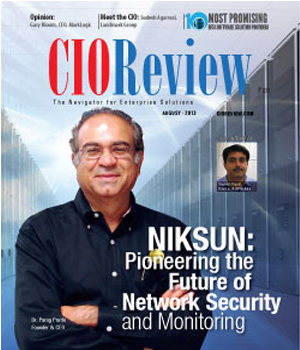
Shaping the Future of AI: Talent, Innovation, and Open-Source
Yann LeCun, Chief AI Scientist at Meta
 Yann LeCun, Chief AI Scientist at Meta in a recent interaction with Nasscom shared his views on why investing in talent and research is critical for AI advancement, how open-source engines are revolutionizing AI scalability for businesses and startups, the role of continuous product innovation in shaping the future of technology and more.
Yann LeCun, Chief AI Scientist at Meta in a recent interaction with Nasscom shared his views on why investing in talent and research is critical for AI advancement, how open-source engines are revolutionizing AI scalability for businesses and startups, the role of continuous product innovation in shaping the future of technology and more.
India is witnessing an inspiring surge in enthusiasm for technology, specifically in the field of AI and this is one of the transformative advancements of our time. I recently interacted with two young entrepreneurs who described their AI startups – displaying groundbreaking innovations which include fine-tuning Lama AI. Interactions like these illustrate the flourishing startup ecosystem in the country. And, these are fueled by open-source contributions as well as collaborative opportunities.
Addressing Gaps in Higher Education & Research Opportunities
There are two issues that hinder the country’s potential in advanced AI research & innovation. Firstly, there is no sufficient motivation for young, talented students and individuals to pursue graduate studies specifically PhDs within India. Most often, such talents would leave the country for higher studies and would not return to contribute to the local ecosystem. Secondly, what discourages students from pursuing long-term academic or industrial research is the limited opportunities they have.
A vibrant research ecosystem needs more than academia and industry research labs should play a pivotal role which fosters innovation via ambitious projects & open collaborations. This model has been perfected in Meta’s FAIR, Google Research and Bell Labs in the United States. These labs have not only advanced technology but they have also created pathways for young researchers to flourish outside conventional academia.
This culture of open, ambitious industry research is scarce outside the US even in European countries as most leading industry research labs in the European countries are operated by American organizations. The situation is even more pronounced in India since there are only a few industry-driven research opportunities available. Also, developing a culture like this in India is crucial to retaining local talent as well as building a sustainable ecosystem.
AI - one of the biggest transformative forces
It is difficult to estimate the reasonable level of investment in AI technology. There is no bubble in AI, however, there is certainly a very high level of investment as a lot of companies have a fear of missing out, a lot of investment companies have fear of missing out and hence a lot of investments are going to a lot of companies. At some point, we are going to see realistic re-normalization of the fact that a lot of those companies are not viable or maybe are viable but not at the level of spending that they are currently doing. For example, some companies have been formed with the idea of training their own foundation models.
It is very difficult for a company which does not have a large source of revenue from other sources such as Meta, Google or Microsoft. If you are a startup and you want to be at the top level to create a trainer Foundation model you might raise a billion but you are going to run through these billion in two years and then are you going to be able to generate the appropriate level of revenue that justifies your valuation within that time frame? Not clear.
I have a lot of friends running those companies; I do not want to discourage them. I do not want to say that they are going to fail but certainly, there is some sort of estimate to do there. What a lot of people are finding is the same factor; it is the same scenario that occurred in AI - in the 80s and 90s, particularly in the late 80s. In the 80s there was a lot of excitement about rule-based systems, and expert systems. And, the hardest job was going to be knowledge engineer, you are going to sit down and talk to human experts about medicine or computer systems etc. and then reduce all that knowledge to a bunch of rules and facts and then feed this to an inference engine that would be able to solve the problem for people.
And that turned out to be partially true but also extremely difficult and expensive to do on a case-by-case basis. Hence, reducing human knowledge to virtual rules turned out to be almost impossible most of the time. And for the situations for which it was possible, it was also expensive. This means the number of applications; and the size of the market for this was much smaller than what the people envisioned.
Thus, most companies went bankrupt. They worked for a while and then went bankrupt. Companies that built hardware for this AI system, and these machines eventually went bankrupt in the early 90s. So have to be careful, where reducing to practice-making systems - the similar scenario that occurred with autonomous driving where 10 years ago people were super excited. There were demos where you could train on the internet to drive a car for 10 minutes on complex Road and that was really impressive and you had lots of demos similar to this. A lot of companies which were created around this idea and lots of even amateurs who would do this, it was relatively easy to do.
However, what was hard and we knew that was that to make those systems sufficiently reliable that you can deploy them is really hard and expensive and requires enormous teams of Engineers and to take care of all the corner cases and everything and productize it.
As a result there are only a handful of companies which can perform this today. It's Tesla, Nvidia and Mobileye and a couple of other companies. Nvidia works with Mercedes, Mobileye works with BMW and other companies. There are few other companies that work on Robot taxi and have a completely different set of Technology. They do not use the same kind of techniques and need the environment to be completely mapped. They use sophisticated LIDAR, sensors and others.
They engineer everything out of these technologies. However, for instance, it is not practical for consumer car. Therefore, those factors turn out to be more difficult than you envision from an impressive demo. Making a product out of an impressive technology is not simple. Thus, companies such as Meta and Google have sufficient funds to keep funding this for a while - at some point they might get tired if we do not make significant progress which is why we have plans for the Next Generation.
Advice for smartly building unique AI/IoT without overspending
Use open source engines because you are not going to train your own foundation model. If you work in the context of language or if you work on other factors such as AI for science, for materials, for image understanding analysis etc. you do not need an LLM but you need other Foundation models and we have them now and Meta is also producing them.
We also have a system called SAM (Segment Anything Model). When you feed an image in this system, it can basically delineate every object in that image and you can control it in some way. That is useful for a lot of applications in biology, in environment protection, in medicine and in all kinds of domains.
There is another system called DINO, DINO V2 in particular and that is a generic feature extractor for images. Therefore, if you have quality control, you need a vision system that can tell you to analyze satellite images or tell you whether a product that you just produced in your factory is fine or has defects in it. You can run DINO, extract your features and then train a very small classifier on top with very little data to get the result you want.
Hence, computer vision systems are constructed simply by reducing the amount of training data required. Therefore, use all the tools at your disposal, do not try to build everything from scratch, and just profit from open source.
A myriad of businesses are into the customization of LLMs or other systems, for vertical applications there is a lot of work to perform and a lot of companies though want to leverage AI have no idea how to use it. Hence a whole ecosystem of startups caters to the requirements of these companies. That is the type of ecosystem that open-source platforms enable. Everyone I have interacted with here be it a founder or engineer in a startup they all use open source platforms and most of them use the Lama AI tool and the others use Dino or SAM.
CIO Viewpoint
Upcoming Technological Advancements in Payments...
By Pinak Chakraborty, CIO of Airtel Payments Bank
Shaping the Future of AI: Talent, Innovation,...
By Yann LeCun, Chief AI Scientist at Meta
Future of Smart Manufacturing: Integrating Tech...
By Mohammed Kaishulla, Chief information officer, EPACK Durable
CXO Insights
Revolutionizing BFSI: The Impact of AI and ML...
By Mike Yesudas, CTO, SunTec Business Solutions
Bridging the Gap: No-Code Platforms and...
By Mr. Muzammil Patel, Global Head Strategy and Corporate Finance at Acies
The Impact of Custom Software on the Indian...



.jpg)



